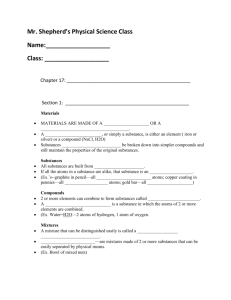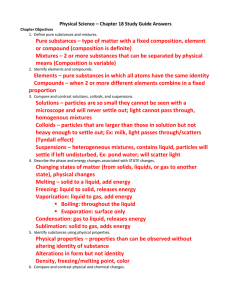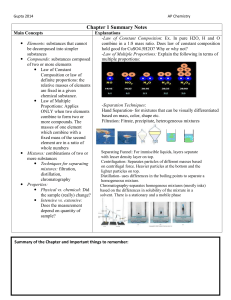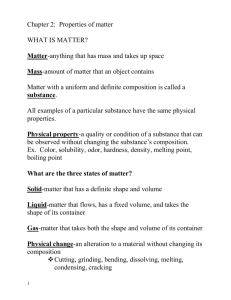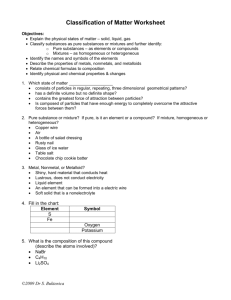Unit 2 Narrative
advertisement
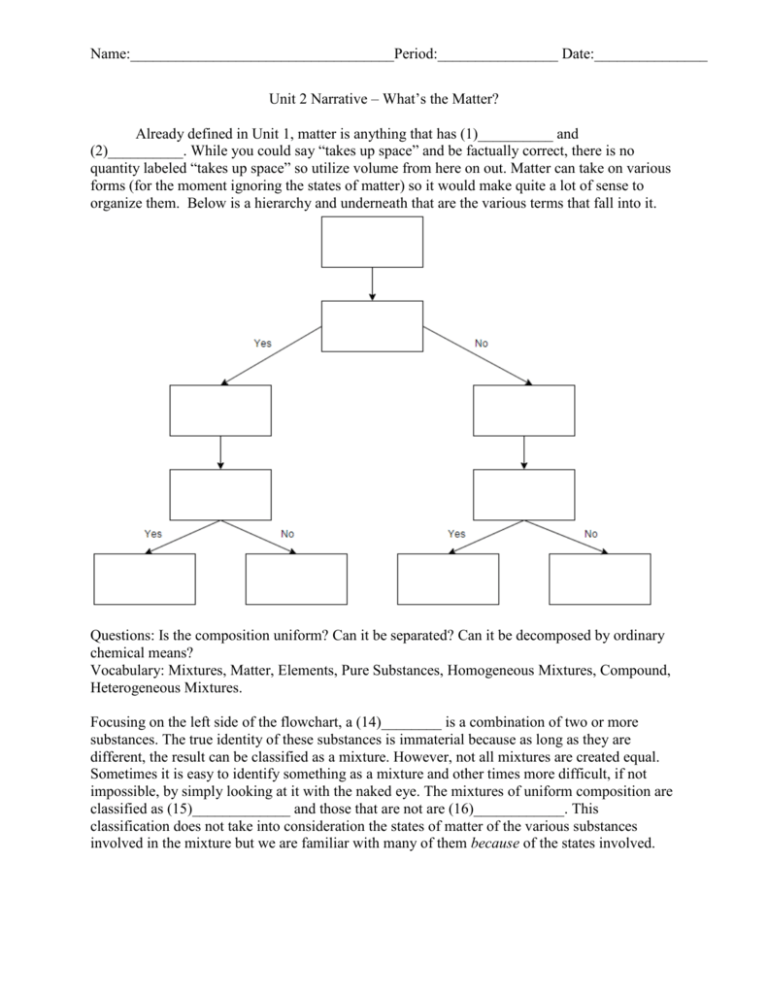
Name:___________________________________Period:________________ Date:_______________ Unit 2 Narrative – What’s the Matter? Already defined in Unit 1, matter is anything that has (1)__________ and (2)__________. While you could say “takes up space” and be factually correct, there is no quantity labeled “takes up space” so utilize volume from here on out. Matter can take on various forms (for the moment ignoring the states of matter) so it would make quite a lot of sense to organize them. Below is a hierarchy and underneath that are the various terms that fall into it. Questions: Is the composition uniform? Can it be separated? Can it be decomposed by ordinary chemical means? Vocabulary: Mixtures, Matter, Elements, Pure Substances, Homogeneous Mixtures, Compound, Heterogeneous Mixtures. Focusing on the left side of the flowchart, a (14)________ is a combination of two or more substances. The true identity of these substances is immaterial because as long as they are different, the result can be classified as a mixture. However, not all mixtures are created equal. Sometimes it is easy to identify something as a mixture and other times more difficult, if not impossible, by simply looking at it with the naked eye. The mixtures of uniform composition are classified as (15)_____________ and those that are not are (16)____________. This classification does not take into consideration the states of matter of the various substances involved in the mixture but we are familiar with many of them because of the states involved. Name:___________________________________Period:________________ Date:_______________ Fill out the chart below with either the state of matter or an example of the mixture. (17-25) State 1 State 2 Example -State 1 State 2 Example Solid Liquid -Gas Fog Liquid Vinegar -Liquid Soda Amalgam -Air Solid Solid The mixtures differ from the pure substances because every pure substance has a (26)______ composition. An individual pure substance has the same make-up, or (27)___________, and the same characteristics, or (28)__________, regardless of where it was found or manufactured. Not everything that has a fixed composition is the same because (29)________ are made out of the same atom but (30)___________ are made out of combinations of different atoms that are (31)________ together. Unlike the compounds, elements (32)__________ be broken down into simpler, stable substances. The Matter flowchart can extend past elements and compounds if we wanted to but that would make it needlessly complicated. Elements themselves can be broken down into various categories. The majority of elements on the periodic table can be classified as (33)_________. These are, to varying degrees, the best (36)_____________ of heat and (37)___________. They are incredibly useful for building and other purposes because they are incredibly (38)_________, which means they can be flattened, and (39)__________, which means they can be drawn into wires. The second largest category of elements are the (40)_____________ which essentially have “opposite” properties of the metals. They are (41)______ conductors of heat and electricity and are often very (42)__________ as they will break or chip when being flattened or manipulated. There are a few elements, however, that do not fit in either of the two categories so they are called (43)___________. Their properties are intermediate of metals and nonmetals, so they are not necessarily as fragile as a nonmetal but not as strong as a metal. Their conductivity is unique and they are often referred to as (44)______________ because of it. Under typical laboratory conditions, the elements exist in one of three states: (45)______, (46)_________, and (47)_______. I am quite sure if you think for a bit you can name a fourth state: (48)___________. This state is often found on earth but it is quite temporary and lightning is a great example. But are those the only states of matter that exist? Do a quick search and report how many you can find (49)______. Do not fret that you found something so ridiculously named like “Quark-gluon plasma” as all the states of matter come down to manner of definition. Each state of matter is defined by the (50)___________ (or behavior) of the particles within. There is a theory that describes the states of matter known as the (51)___________ __________ ________ or KMT for short which focuses on the movement of the particles in each state of matter. This behavior also explains the properties of the substance as a solid, liquid, or gas. When we describe what makes a substance a solid, liquid, gas, or plasma we will focus on the structure (or arrangement) of particles and the movement. Keep in mind that the difference between each state does not have to be incredibly drastic even if their appearance (ice v steam) suggests so. Keep the terminology you use fundamental and simplified. It will go a long way towards a proper understanding of the various states of matter. Name:___________________________________Period:________________ Date:_______________ In the four boxes below, draw what you feel the particles (atoms or molecules) look like in the various states of matter. The box is oddly shaped with that triangle on the bottom and you must take that into account. (52-55) Solid Liquid Gas Plasma One way to figure out the major differences between the states of matter is to look at 1) the shape, 2) the volume, 3) the position of particles, 4) the movement of particles, and 5) the charge on the particles. (56-75) Solid Liquid Gas Plasma Shape Volume Particle Position Particle Movement Charge Solids always maintain their shape regardless of what type of container it is in. A consequence to this is their dimensions also remain constant. So if the shape does not change and the dimensions do not change that means the volume also does not change. This means the two properties are fixed. Now if the shape is not changing then the particles cannot be moving very much if at all but from prior experience we know that energy can cause objects to get very hot and we know energy is associated with movement. Atoms are always moving – no matter the state – but in a solid their movement is very limited (vibrating in place) and the position is fixed. Lastly, matter is made of atoms that contain protons and electrons which carry charges but do you get shocked when you touch the desk in front of you? No. Excluding temporary static charges, a solid is neutral. Utilizing this paragraph as a guide, determine the remainder of the chart and then adjust your drawings of particles in the various states of matter below. (76-79) Solid Liquid Gas Plasma Name:___________________________________Period:________________ Date:_______________ As our experiences have shown us, a substance can undergo a transition from solid to liquid or gas to liquid among others. When substances interact with each other and react, the change can be even more radical. Regardless of the type of change occurring, there are two laws that must be obeyed. The first is the Law of (80)_______________of___________ which states that matter cannot be (81)_____________ nor (82)______________. In other words, if 20g is the total amount of material before a process occurs then 20g must be the total after. There is a bit of a catch to this rule and that the reaction must be (83)______________ as nuclear processes occur all the time and those can result in a reduction of mass. The other is the Law of (84)________________of__________ which states that the total amount of (85)_________ present in a system will remain constant. The characteristics of a substance can be classified in terms of what it looks like or its behavior (with respect to other substances). These characteristics are referred to as (86)______________ and can be either (87)_____________ or (88)_____________. All physical properties include those that can be described by sight or feel, such as color or texture. Others can be measured (89)___________ changing the substances identity. For example, the melting point of a substance can be determined and all you have done is change the state of matter from solid to liquid. The physical property would be the temperature at which melting occurred while the physical (90)__________ would be the actual transition from solid to liquid (melting). The substance is still the same before and after. (91)__________ properties, however, reflect the ability of a substance to change identity. These properties can be as simple as what the substance can react with or what it does not. The actual chemical change is also referred to as a chemical (92)_____________. A chemical property of hydrogen is that it is reactive with oxygen. A chemical change involving hydrogen would be the Hindenburg disaster. There are numerous terms that are used to describe a physical change like the world melting above. There are 6 potential changes from one state (the common 3) of matter to another but there are 7 words used to describe them. Below is a chart that contains boxes for the 3 states of matter and lines (and direction of the arrow is very important) for the 7 changes in state which you should fill out accordingly. (93-102)
